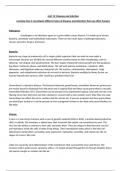Unit 12: Diseases and Infection
Learning Aim A: Investigate different types of diseases and infections that can affect humans
Pathogens:
A pathogen is an infectious agent or a germ which causes disease. It is made up of viruses,
bacteria, unicellular and multicellular eukaryotes. There are five main types of pathogens(bacteria,
viruses, parasites, fungus, protozoa).
Bacteria:
Bacteria are a type of prokaryotic cell (a single-celled organism) that can only be seen under a
microscope. Bacteria are divided into several different varieties based on their morphology, such as
spherical, rod-shaped, and spiral bacteria. The four stages of bacterial colony growth are the lag phase,
log phase, stationary phase, and death phase. The cell wall, plasma membrane, cytoplasm, DNA,
ribosomes, and flagellum make up a bacterial cell. The nucleus, mitochondria, chloroplasts, Golgi
apparatus, and endoplasmic reticulum do not exist in bacteria. Bacteria multiply by binary fission, an
asexual reproduction process, after reaching a predetermined size.
Gonorrhoea is a bacteria disease. The bacteria Neisseria gonorrhoeae, sometimes known as gonococcus
are mainly found in discharge from the penis and in vaginal fluid and these cause gonorrhoea a sexually
transmitted infection (STI). Gonorrhoea can be passed on by unprotected vaginal, anal and oral sex or by
sharing of sex toys that have not been cleaned or covered with a new condom every time they are used.
Gonorrhoea can affect the cervix, urethra and the rectum etc. If you are pregnant and have gonorrhoea
you should get tested as it can be passed on from a pregnant women to her baby and cause blindness to
the baby.
Viruses:
A virus is a non-living structure with a core of genetic material (DNA or RNA), a protein-based protective
shell, a carbide. The envelope, a spikey layer that surrounds the capsid, can sometimes be seen. The
virus has the ability to connect to host cells and enter them. They are unique in that they only can live
and reproduce inside the cells of other living things. Their reproduction takes place in the host cell.
Attachment, penetration, uncoating, gene expression, replication, assembly, and release are the six
stages of a virus's life cycle.
Colds are caused by viral inflammation of the membranes that surround the nose and throat. The
common cold is quite easy to spread to others. It's mainly spread through the air through droplets that a
sick person coughs or sneezes into the air.




